CREATE research project seeks technologies for teaming artificial intelligence (AI) autonomous machines
ARLINGTON, Va. – U.S. military researchers are working with industry to find new ways of teaming artificially intelligent systems autonomously that can react to and learn from unexpected missions in the absence of centralized communications and control.
Officials of the U.S. Defense Advanced Research Projects Agency (DARPA) in Arlington, Va., issued an artificial intelligence exploration (AIE) opportunity on Tuesday (DARPA-PA-19-03-01) for the Context Reasoning for Autonomous Teaming (CREATE) project.
CREATE is investigating new approaches for autonomous teaming of physically distributed groups of military autonomous machines when there is limited opportunity for centralized coordination.
The project aims to explore the utility of artificial intelligence (AI) on the autonomous formation of scalable machine-to-machine teams, and develop the theoretical foundations of autonomous AI teaming to pursue several simultaneous and unplanned mission goals -- especially in degraded communications conditions.
CREATE focuses on teaming among size, weight, and power (SWaP)-constrained systems like unmanned aerial vehicles (UAVs), unmanned underwater vehicles (UUVs), unattended ground sensors, satellites, and similar systems.
An artificially intelligent autonomous machine working in a team will be able to understand how its own sensing and actuation modes relate to several high-level mission goals to help machine team members balance their resources autonomously.
Context enables humans and machines to form hypotheses and infer relationships to better understand observations and events, and will help artificially intelligent machines disregard the irrelevant and focus on the meaningful.
Until now, autonomy research for systems like UAVs, satellites, unattended ground sensors, and robots has focused primarily on improving the performance of individual system sensing and behaviors.
All of these approaches, however, rely on static and pre-defined objective functions, static swarm behaviors, or other Markov Decision Processes (MDPs) that significantly limit the team’s ability to react to unexpected missions or balance competing mission objectives.
Context reasoning, on the other hand, is the use of implicitly given facts, relationships, and models from dynamically changing internal or external knowledge stores to enable machine understanding of sensing and commands to improve autonomous decision making.
The CREATE project will have two phases over 18 months: a six-month feasibility study, and a yearlong proof of concept option. The total award value for all phases is about $1 million, include performer cost share, if necessary.
Related: Artificial intelligence (AI) in unmanned vehicles
The feasibility study will show the value of AI to machine teaming with simulation and quantitative analysis. Proofs of concept will continue to refine AI teaming techniques and algorithms started in the feasibility studies, and demonstrate that techniques can be hosted on one or more SWaP-constrained system.
DARPA officials would like to start the CREATE program on 29 Nov. 2019. Full proposals are due no later than 3 Oct. 2019. Email questions or concerns to DARPA's Aaron Kofford, the CREATE program manager, at [email protected].
More information is online at https://www.fbo.gov/spg/ODA/DARPA/CMO/DARPA-PA-19-03-01/listing.html.
About the Author
John Keller
Editor-in-Chief
John Keller is the Editor-in-Chief, Military & Aerospace Electronics Magazine--provides extensive coverage and analysis of enabling electronics and optoelectronic technologies in military, space and commercial aviation applications. John has been a member of the Military & Aerospace Electronics staff since 1989 and chief editor since 1995.
